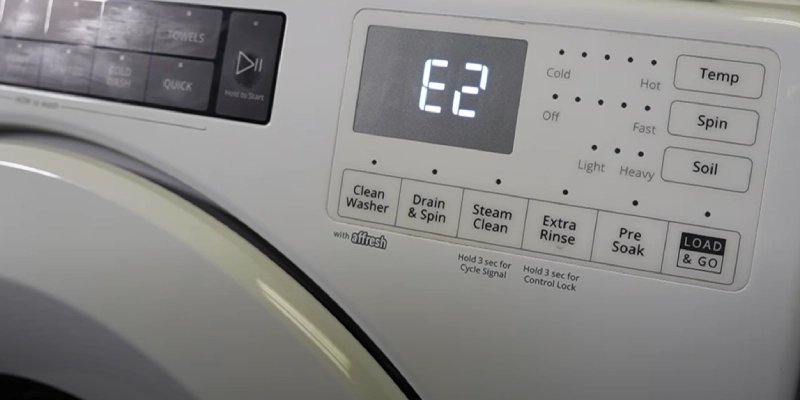
Picture this: you’re doing your laundry, expecting the usual whirr and hum of a regular wash cycle, when suddenly, the machine stops and flashes an unfamiliar code. It’s the error code ‘OE’, indicating a problem with draining the water. This can be as frustrating as a sudden traffic stop when you’re rushing. But don’t worry, we’re here to unravel what this code means and whether you can get it fixed without dipping into your pocket.
Understanding the ‘OE’ Error Code
The ‘OE’ error code is your Whirlpool washing machine’s way of telling you it’s having trouble draining. You might think of it like a bathtub that won’t let the water flow out, getting stuck in a state of overflow. Typically, this error indicates there might be a blockage or restriction in the drain hose, pump, or somewhere else in the drainage system.
When a Whirlpool washing machine displays this error, it’s important to check the drain hose first. Often, it can get kinked or clogged with small bits of thread, lint, or whatever might have come loose from your clothes—like that pocket change or those pesky tissues. A blocked drain pump filter can also trigger this code. Remember how a vacuum cleaner struggles if its bag is full? Similarly, if the filter is clogged, the machine can’t drain properly, resulting in this error.
Another potential culprit could be a malfunctioning drain pump. Imagine trying to suck a drink through a cracked straw; the pump has to work harder and may not be able to drain the water as needed. If the machine detects that it’s taking too long to empty, it’ll stop and alert you with the ‘OE’ code. Addressing these issues promptly is crucial to prevent water from standing in the drum, potentially leading to more significant problems.
Is the ‘OE’ Error Code Covered Under Warranty?
Getting a new washing machine often comes with the comfort of a warranty—a promise that the manufacturer stands by their product. So, where does the ‘OE’ error fit into this? Generally, warranties cover defects in materials or workmanship, but they don’t cover issues stemming from regular wear and tear or misuse.
In most cases, if the ‘OE’ error results from a manufactural defect, like a faulty pump that’s been problematic from the start, it should be covered. Think of it like a car part that’s faulty due to poor manufacturing. However, if the issue arises due to blockages from debris or improper use, like using the wrong detergent or overloading the machine, it may not be covered.
Before claiming warranty service, it’s wise to check whether the error indeed stems from a defect. Whirlpool typically provides a manual or online resources to help you troubleshoot. If you’re sure it’s a defect, reaching out to Whirlpool’s customer service or the retailer where you purchased the machine is your next step. They can guide you through filing a warranty claim, ensuring you’re not left alone in a sea of technical jargon.
Steps to Take When You Encounter the ‘OE’ Error
Faced with the dreaded ‘OE’ error? Here’s the deal: rather than panic, start with some basic troubleshooting. First, inspect the drainage hose for any obvious kinks or blockages. The hose should be free of clogs and placed correctly. It’s much like making sure a garden hose is unkinked before watering the plants.
Next, check the drain pump filter. This filter tends to catch loose fabrics and lint, much like the lint catcher in your dryer. If it’s clogged, gently clean it out. Be prepared for any water that might spill out once you open it, as a small towel can come in handy.
If your efforts don’t resolve the issue, it might be time to call in a professional. A certified technician can help identify whether it’s a warranty-covered repair or if other steps need to be taken. While waiting for assistance, avoid using the machine to prevent further damage—treat it like a computer in need of repair, best left untouched until an expert arrives.
Preventing Future ‘OE’ Errors
Once you’ve tackled the ‘OE’ error, you’re probably eager to avoid it in the future. Regular maintenance is key. Consider it like keeping a car running smoothly with regular oil changes. Start by routinely cleaning your washing machine’s filter and checking the drainage hose for any build-up or obstructions.
Try using the appropriate detergent and not overloading the machine, as this can put undue strain on its drainage system. It’s a bit like stuffing a suitcase to the brim—it might withstand it occasionally, but consistently doing so can cause stress and lead to issues.
Additionally, running a maintenance wash every month or so can help keep things in working order. This involves using a machine cleaner or a mixture of vinegar and baking soda to clear out any accumulated residues. Think of it as giving your machine a spa day—helping it stay fresh and functional.
In conclusion, while dealing with the ‘OE’ error can be a hassle, understanding its causes and ensuring your machine is under warranty can ease the burden. With a few preventative measures, you can enjoy hassle-free laundry days, leaving you time for more enjoyable pursuits.